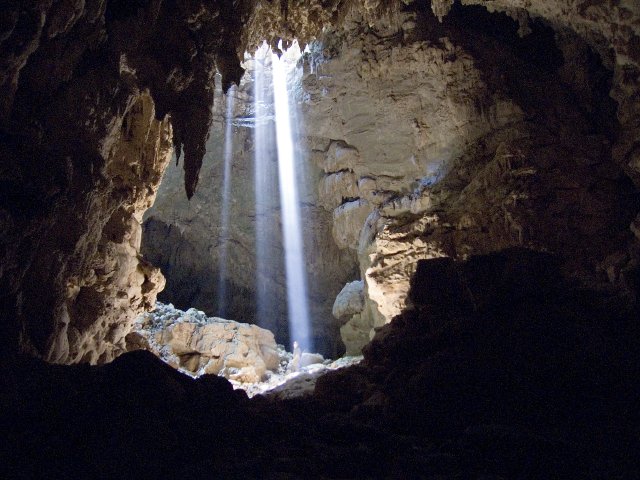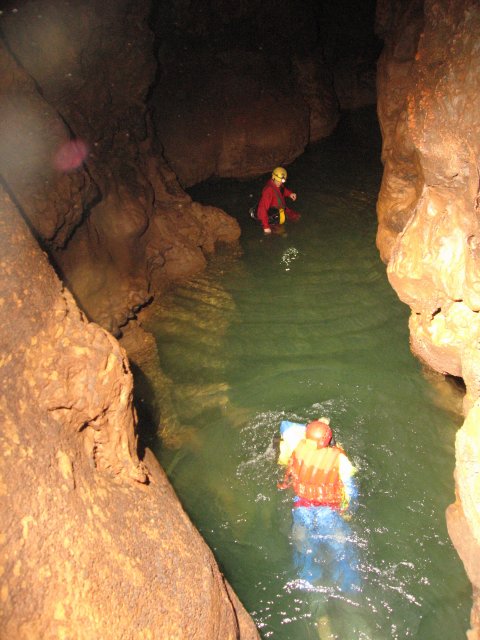Cave Name: Tich Hulz.
Alternate Names: Tiger Cave, San Miguel Cave, Jaguar Cave
District: Toledo
Area: Rio Grande
Location: Co-ordinates logged with the Belize Institute of Archaeology
Altitude: 36m
Length: >5100m
Depth: -74m
History of exploration:
In 1979 the cave is discovered and entered by members of the US Peace Corp.
In the years 1985-86 the cave is systematically explored and surveyed by members of the “NSS Rio Grande Project”. Main dry cave is explored to conclusion, side passage explored to underground river, “The Roaring River”.
In 2006 Hydro Maya build a hydro plant at the mouth of Kangaroo Cave, seriously altering water courses and lowering the previously inaccessible Roaring River section, within Tiger Cave.
In 2008 SWCC enter the Roaring River section and explore upstream and downstream, extending the cave by 0.5 km.
In 2010 SWCC discover a new entrance, called “Green Pit”, entering upstream of the Roaring River, enabling a through trip. In addition the ‘Roaring Pit’ section was entered, discovering a second stream way trending away from the main cave.
In 2013 SWCC discover new section near downstream end of the Roaring RIver section of Tiger Cave.
Description:
The main entrance has 2 possible ways in, either low on the left hand side, or a climb up on the right. Both ways meet up in the main cave. A large passage continues until a jungle skylight is encountered. Immediately after the skylight the section with ‘steps’, is reached. Climbing up to the right leads to a platform overlooking the cave.
Down and to the left is the way on into the main cave. The cave continues in a large impressive passage before an obvious mud slope down to the right marks the start of the route to the Roaring River section.
Staying high and left continues in the main cave, past the Roaring Pit section on the left. Another large skylight entrance is reached.
The main passage continues to meet the ‘Horsehead Room’ where two possible routes are available. To the left a smaller series of passages leads via the ‘Calcite Ice’ section before connecting with ‘The Slide’. Straight ahead at the Horsehead Rooms is the easy option and soon leads to the second jungle entrance and an obvious large muddy climb is the way on.
At the top of the climb the large impressive ‘Belikin Room’ is reached. Staying high in the chamber leads to a second large chamber, the ‘Mayan Temple Room’. Down and left here leads to the 3rd jungle entrance and to the right leads to the very impressive ‘Crab Shell Room’. These chambers contain some pottery remains.
Back in the ‘Belikin Room’, the route on is down and to the left, meeting up with ‘The Slide’. The cave narrows before an obvious climb up ‘Docs Didn’t Go’, with a hand line in situ, leads to a gour pool. A short low section soon opens out into ‘The New Frontier’. The main passage continues with impressive dimensions. A crawl to the left leads to ‘West Virginia Passage and another chamber, ‘The Milk Room’. The main ‘New Frontier’ passage continues before lowering into more shattered water worn rock and an obvious junction ‘Jump Off’. Right at the junction leads back to the Milk Room and down leads to a small network of water logged passages. Climbing up at the junction leads to the muddy ‘AA Survey Passage’ before spitting with the main right hand route leading to the upstream sump.
The Roaring River section is a section of long water passage requiring long periods of swimming. At the end of the swims a duck under flowstone is followed by a 5m climb down into the main stream way. The once wall to wall white water is now significantly reduced and it is possible to traverse upstream and downstream.
Downstream leads via a more water logged passage before splitting. The left hand branch leads to the downstream sump and the right hand branch leads to some more swims heading back in the direction of the main cave. Upstream leads to a further climb before connecting with the newly discovered Green Pit entrance series.
2010 discoveries.
The Roaring Pit section is a 15m climb down to a pool. A wade through the pool leads round the corner to a small chamber. There is a route high up on the left and one down to the right. Following the route to the right, a low airspace swim though a fast moving stream way is encountered, from the other side of the airspace a climb out leads to a large chamber with 2 main ways on. To the right the stream way is rejoined with an upstream sump encountered approx 50m further on. A smaller inlet is encountered further downstream which extends for approx 100m via some canals to a low airspace duck that closes down.
The main way on from the large chamber is straight ahead. A large passage for 200m continues until a silted passage is met which may needs to be excavated. The passage leads to a cross rift with a small upstream sump and a final muddy crawl to a low draughting passage with the sound of bats in the distance.
Taking the high level route left at the large chamber another route upwards, leads back to the initial high level route seen in the first chamber. However, carrying on the stream way is encountered once more, with some large deep sump pools but no apparent way on.
2013 discoveries.
Downstream in the “Roaring River” just before the downstream sump is an obvious 7m high slab. This is an awkward climb to the new section of passage. At the top there is muddy passage on the left and flowing water on the right going over calcite. The passage can be followed upstream to a large inlet pool. Turning right the passage lowers and descends down through gour pools to reach a large 5m high with potential passage at top.
The passage continues with swims, following the water downstream, passing an inlet on the right (no potential) to a climb down a small rift into a deep narrow pool, the 'Cracking Canyon'. Swim under a waterfall and continue downstream to an obvious climb out of water onto a false floor. At this point water emerges from several head height holes in the roof before disappearing under the calcite floor. Further traverses over crumbly calcite and false floors lead to a continuation of the passage – unexplored.
The direction of the passage heads east towards Mucbe Cave, probably beyond the upstream sump of Mucbe cave.
The quantity and different direction of water in the passage suggests the flow may be relative to the above hydro canal, which is known to spring leaks that would flow directly into the cave. Once the leaks are fixed, the level of water is likely to drop.
Cultural:
Details on archaeology and cultural remains are available from the IA.
Survey:
Tiger Cave Survey (2010)
Links:
http://www.southernbelize.com/caves.html
References:
NSS Rio Grande Project. (1985).
SWCC Belize Report (2008, 2010, 2013).



